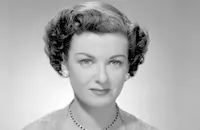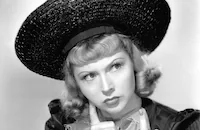Trade Winds

Brief Synopsis
Cast & Crew
Tay Garnett
Fredric March
Joan Bennett
Ralph Bellamy
Ann Sothern
Sidney Blackmer
Film Details
Technical Specs

Synopsis
The night that San Francisco socialite Kay Kerrigan has to identify the body of her younger sister in the morgue, she confronts millionaire playboy Thomas Bruhm II in his apartment. Kay blames her sister's suicide on the callous Bruhm, who hands her his gun and blithely tells her to shoot. Enraged and humiliated, Kay shoots at Bruhm's stomach and he falls dead. After Kay hastily leaves, police detective Ben "Homer" Blodgett sees Bruhm's body with a fatal bullet in the back of his head and, finding Kay's handbag, deduces that she is the murderer. When an all-points bulletin is issued for her arrest, Kay drives her car into the bay, making the police believe that she is also a suicide victim. Some time later, in Hawaii, Kay pawns a unique piece of her jewelry, and Police Commissioner Blackton knows that she did not die. Not trusting the bumbling Homer's capacity to track Kay down, the commissioner contacts former policeman Sam Wye, a brilliant detective who specializes in finding, and romancing, women. Sam leaves his creditors and his fuming secretary Jean Livingstone behind and heads for Hawaii, accompanied by Homer. After charming some hairdressers, Sam discovers that Jean changed from blonde to brunette and sailed for Japan. Homer and Sam then search for Kay throughout the Orient. While Homer looks at tobacco shops asking if a woman has purchased Kay's special brand of Egyptian cigarettes, Sam goes to cafes trying to see if a woman has been playing Frédéric Chopin's "Andantino in A Flat Major," Kay's favorite melody, on the piano. When Homer thinks he has found the woman, it turns out to be Jean, who followed Sam to rekindle their old romance and collect a $100,000 reward now being offered by Bruhm's father. Jean also has a photo of Kay and the tip that she is travelling on a British passport as "Mary Holden." On a boat sailing toward Saigon, Sam finally meets Kay, and immediately falls in love with her. He doesn't let her know that he is a detective, and she falls in love with him as well. Now jealous as well as miffed over Sam's attempts to keep her from collecting part of the reward, Jean poses as a missionary's daughter and becomes friendly with Kay herself. She also helps Kay when she thinks that Sam secretly wired for the reward. Travelling from port to port, Jean, who is now very fond of Kay, helps her get away, then when Sam finds them again, she goes with them on a slow boat back to San Francisco after Kay decides that she no longer wants to be a fugitive. In order to help Kay avoid capture from rival police detective George Faulkner, Sam makes Faulkner believe that Jean is Kay, long enough for him to take Kay to a distant island. When Faulkner does track them down, Sam intends to shoot him, but Faulkner wounds him instead and Sam suddenly says that he has captured Kay for the reward. Back in San Francisco, the press calls Sam a "heel" for turning in his sweetheart, and even Homer and Jean, who have fallen in love with each other, think that Sam is a cad. After collecting the reward, Sam buys Bruhm's apartment and invites all of Bruhm's old girl friends to a party. During the party, he reveals to Homer that he has discovered that Kay's gun actually had blanks in it and thinks that Bruhm was killed from behind by a jealous lover. By rigging up a phony radio broadcast, Sam makes the real killer, Mr. Johnson, think that Kay has been found guilty of murder, and coerces him into confessing that he killed Bruhm for having an affair with Mrs. Johnson. Now free from the murder charge, Kay marries Sam, who finally has shaken his image as a cad.

Director

Tay Garnett
Cast

Fredric March

Joan Bennett

Ralph Bellamy

Ann Sothern

Sidney Blackmer

Thomas Mitchell
Robert Elliott

Joyce Compton
Richard Tucker
Charles Williams
Patricia Farr
Wilma Francis
Phyllis Barry

Dorothy Tree
Kay Linaker

Linda Winters
Walter Byron
Wilson Benge
Harry Payne
Hooper Atchley
Franklin Parker

Lee Phelps
John Webb Dillon
Dick Rush
Mrs. Sojin
Princess Luana
Marie De Forest
Beryl Wallace
Paulita Arvizu
Aiko Magara
Suzanne Kaaren
Gloria Youngblood
Lotus Liu
Ethelreda Leopold
Crew
Frank R. Adams
Ray Binger
Alan Campbell
Frédéric Chopin
Tay Garnett
Tay Garnett
Alexander Golitzen
Percy Ikerd
Irene
Daniel Keefe
Otto Lovering
Frank Maher
Rudolph Maté
Alfred Newman
Dorothy Parker
Walt Reynolds
Nina Roberts
Ned Scott
James B. Shackelford
Dorothy Spencer
Helen Taylor
Alexander Toluboff
Alexander Toluboff
Walter Wanger

Videos
Movie Clip



Film Details
Technical Specs

Articles
Trade Winds
Bennett plays Kay Kerrigan, a San Francisco socialite wanted for the murder of a millionaire playboy responsible for her sister's suicide. Faking her own death and dying her hair, Kerrigan takes off for the Orient, pursued by bumbling city detective Ben "Homer" Blodgett (Ralph Bellamy) and former policeman turned private eye Sam Wye (March) who specializes in tracking and romancing women. Kerrigan meets Wye on board a ship and, not knowing he's pursuing her, begins to fall for him.
The character's change of hair color proved to be more than a plot device for Bennett. Known as a blonde for the first decade of her career (like her older sister, thirties star Constance Bennett), Joan's change to brunette impressed Wanger, who had been guiding her career since she signed a personal contract with him some five years before Trade Winds. Wanger thought the new look bore a striking resemblance to another young actress just then making a big splash in Hollywood, Hedy Lamarr; her American premiere, Algiers (1938), was produced by Wanger. He insisted Bennett stay brunette from this point on. He wasn't the only one who noticed the similarities; songwriter Cole Porter penned this line in his song, "Let's Not Talk About Love": "Let's speak of Lamarr, that Hedy so fair; why does she let Joan Bennett wear all her old hair?" The success of Bennett's long career has been credited at least in part to this change in look, altering her image from fair-haired ingénue to sultry femme fatale.
Joan Bennett wasn't the only actress to get a professional boost from Trade Winds. Cast as March's wisecracking Gal Friday and would-be sweetheart, Ann Sothern, who had been languishing at RKO, showed considerable comic skills. Executives at MGM took notice, signed her to a long-term contract, and cast her in a similar role in Maisie (1939), a film originally meant for Jean Harlow before her early death. The success of that comedy led to eight sequels over the next eight years, all starring Sothern.
The two males in Trade Winds needed no help in their careers. March had just made two big hits, the drama A Star Is Born (1937) and the comedy Nothing Sacred (1937), as well as a turn as Jean Lafitte in Cecil B. DeMille's pirate adventure The Buccaneer (1938). Bellamy, the perennial "other man" in 1930s comedies and romances, had just cemented his reputation in that type of role as the guy who fails to come between Cary Grant and Irene Dunne in The Awful Truth (1937) and Fred Astaire and Ginger Rogers in Carefree (1938).
Also in the cast is Linda Winters, who would change her name back to Dorothy Comingore in a few years. Under that name, she played the second wife of millionaire newspaper publisher Charles Foster Kane in Orson Welles's landmark film Citizen Kane (1941). A promising actress, Comingore's career was cut short by the Hollywood Blacklist in the early 1950s.
Several sources, including Garnett's autobiography, note that some background footage in Trade Winds was made by Garnett on an Asian tour prior to developing the story. It's not clear how much of Garnett's footage was used, since other craftsmen are credited with "foreign exterior" and process photography. Reviews at the time attributed the film with the most extensive use of the rear-projection process to that date. It even figured prominently in Frank S. Nugent's New York Times review: "Tay Garnett earned the distinction yesterday of being probably the first man in history with the temerity to invite 80,000,000 persons to pay to see the movies he took on a world cruise. Mr. Garnett went abroad a few seasons ago and, having a rough outline of a script, he shot doorways in Japan, barrooms in Indo-China, the race track at Singapore, a pier in Bombay, a fishing village in the Laccadives, a twisting street in pre-war Shanghai. ... The result of it all is Trade Winds, which blew gently into the Music Hall yesterday and may be remembered by posterity as the process shot that went 'round the world'.... Mr. Garnett must have had a grand trip."
Director: Tay Garnett
Producers: Tay Garnett, Walter Wanger
Screenplay: Dorothy Parker and Alan Campbell, Frank R. Adams
Cinematography: Rudolph Maté
Editing: Otho Lovering, Dorothy Spencer
Art Direction: Alexander Toluboff
Original Music: Alfred Newman (uncredited)
Cast: Fredric March (Sam Wye), Joan Bennett (Kay Kerrigan), Ralph Bellamy (Ben Blodgett), Ann Sothern (Jeanne Livingstone), Thomas Mitchell (Commissioner Blackton).
BW-93m.
by Rob Nixon

Trade Winds
Quotes
Trivia
Ann Sothern's character proved so popular in this movie, it was spun off to create series of "Maisie" films.
Notes
According to several news items in Hollywood Reporter, Tay Garnett had planned to make this film as early as 1936. It was reported at one point that he intended to make the picture for Columbia with Cary Grant, based on a script by Gene Towne and Graham Baker. At another point it was reported that he went to England to produce the film there but abandoned the idea. Reviews, Garnett's autobiography and other modern sources discuss the use of some process footage in the film which was made by Garnett on an Asian tour prior to his writing the original story. As James B. Shacklelford is credited onscreen with "foreign exterior photography, and Ray Binger is credited in reviews with process photography, it is unclear how much of Garnett's personal film was used in the picture. At the time of the film's release reviews noted that it used more process photography than any previous non-documentary feature. An article in International Photographer noted that Trade Winds was the first production in which rear projection was an "integral part of the production program," and the New York Times reviewer referred to the production as "the process shot heard 'round the world." The article also mentioned that the picture cost close to $750,000 to make.
A January 5, 1939 news item in Hollywood Reporter noted that Garnett was planning to write another original story entitled World Cruise, the original title of Trade Winds, so that he could incorporate background footage of Europe and North Africa not incorporated in the 1938 picture. Such a film was never made. The Motion Picture Herald "in the Cutting Room" review includes Alan Baxter and Armand Cortez in the cast, but they were not seen in the viewed print and their roles May have been cut prior to the film's release. The Motion Picture Herald "Showmen's Review" lists Robert Emmett O'Connor in the role "Chief of detectives." Some other sources list Thomas Mitchell's character as "Chief of detectives," although onscreen the character's name is "Police commissioner." O'Connor is not listed in any other source, and his inclusion in Motion Picture Herald is probably an error. Joan Bennett, who was a blonde prior to Trade Winds, remained a brunette for the rest of her life. Modern sources frequently attribute her motion picture successes of the 1940s to her new look and to the career guidance given to her by producer Walter Wanger, her husband from 1940 to the early 1960s.














